 |
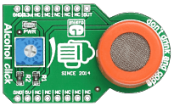
|
|
Alcohol click carries an MQ-3 Semiconductor sensor for alcohol. The gas sensing layer on the sensor unit is made of Tin dioxide (SnO2), an inorganic compound which has lower conductivity in clean air. The conductivity increases as the levels of alcohol gas rise. Alcohol click has a high sensitivity to alcohol and it can be used to detect alcohol in concentrations from 0.04 to 4mg/l. To calibrate the sensor for the environment you’ll be using it in, Alcohol click has a small potentiometer that allows you to adjust the Load Resistance of the sensor circuit. Alcohol click communicates with the target board through AN (OUT) mikroBUS line. The board is designed to use a 5V power supply only. |
|
|
|
 |

|
|
Alcohol 2 click is a very accurate ethanol gas (alcohol) sensor Click board™, equipped with the SPEC amperometric gas sensor which electrochemically reacts with the ethanol. It is supported by the LMP91000, a high-precision integrated analog front-end IC (AFE), perfectly suited for use in electrochemical sensing applications. The Click board™ also provides the reference voltage required by the sensor and offers a choice between the analog output from the AFE IC buffered with the low noise op-amp, and digital output from the 12-bit SAR A/D converter. |
|
|
|
 |
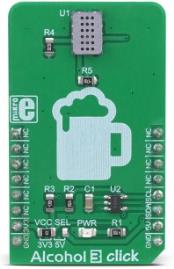
|
|
Alcohol 3 click is a gas sensor Click board™, equipped with the MiCS-5524, a compact metal oxide (MOS) sensor. This sensor reacts to the presence of deoxidizing and reducing gases, such as ethanol (also known as alcohol). Its impedance changes as a result of a catalytic reaction, allowing it to be used in a voltage divider configuration. This voltage can be sampled by an accurate A/D converter (ADC), allowing data to be read directly over the I2C interface. The MiCS-5524 sensor itself is a robust sensor, which can be used in harsh environment for gas leakage detection, in breath checking applications, early fire detection, etc.
Alcohol 3 click is supported by a mikroSDK compliant library, which includes functions that simplify software development. This Click board™ comes as a fully tested product, ready to be used on a system equipped with the mikroBUS™ socket.
|
|
|
|
 |

|
|
LPG click carries an MQ-5 sensor for detecting liquefied petroleum gas leakage. The gas sensing layer on the sensor unit is made of Tin dioxide (SnO2), which has lower conductivity in clean air. The conductivity increases as the levels of LPG rise. The detection range of the sensor is 200-10000 ppm of LPG. To calibrate the sensor for the environment you'll be using it in, LPG click has a small potentiometer that allows you to adjust the Load Resistance of the sensor circuit. For precise calibration the sensor needs to preheat (once powered up, it takes 24h to reach the right temperature). LPG click communicates with the target board through AN (OUT) mikroBUS line. The board is designed to use a 5V power supply only. |
|
|
|
 |
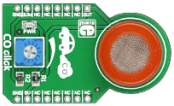
|
|
CO click carries an MQ-7 sensor for Carbon monoxide. The gas sensing layer on the sensor unit is made of Tin dioxide (SnO2), which has lower conductivity in clean air. The conductivity increases as the levels of Carbon monoxide rise. The detection range of the sensor is 20ppm-2000ppm of CO. To calibrate the sensor for the environment you’ll be using it in, CO click has a small potentiometer that allows you to adjust the Load Resistance of the sensor circuit. For precise calibration the sensor needs to preheat (once powered up, it takes 48h to reach the right temperature). CO click communicates with the target board through AN (OUT) mikroBUS line. The board is designed to use a 5V power supply only. |
|
|
|
 |
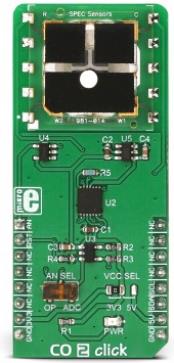
|
|
CO 2 click is a very accurate, carbon-monoxide-gas-sensor Click board™, equipped with the SPEC amperometric, 3SP CO 1000 gas sensor which electrochemically reacts with the carbon monoxide (CO). It is supported by the LMP91000, a high-precision integrated analog front-end IC (AFE), perfectly suited for use in electrochemical, sensing applications. The Click board™ also provides the reference voltage required by the sensor and it offers a choice between the analog output from the AFE IC buffered with the low noise op-amp, and the digital output from the 12-bit SAR A/D converter. |
|
|
|
 |
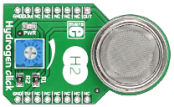
|
|
Hydrogen click carries an MQ-8 sensor for hydrogen (H2). The gas sensing layer on the sensor unit is made of tin dioxide (SnO2), which has lower conductivity in clean air. The conductivity increases as the levels of hydrogen rise. The detection range of the sensor is 100-10000ppm of hydrogen. To calibrate the sensor for the environment you’ll be using it in, Hydrogen click has a small potentiometer that allows you to adjust the load resistance of the sensor circuit. For precise calibration the sensor needs to preheat (once powered up, it takes over 24h to reach the right temperature). Hydrogen click communicates with the target board through AN (OUT) mikroBUS line. It's designed to use a 5V power supply only. |
|
|
|
 |
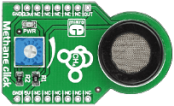
|
|
Methane click carries an MQ-4 sensor for methane (CH4). The gas sensing layer on the sensor unit is made of tin dioxide (SnO2), which has lower conductivity in clean air. The conductivity increases as the levels of methane rise. The detection range of the sensor is 200-10000ppm of methane. To calibrate the sensor for the environment you'll be using it in, Methane click has a small potentiometer that allows you to adjust the load resistance of the sensor circuit. For precise calibration the sensor needs to preheat (once powered up, it takes 24h to reach the right temperature). Methane click communicates with the target board through AN (OUT) mikroBUS line. The board is designed to use a 5V power supply only |
|
|
|
 |
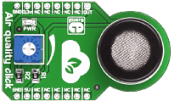
|
|
Air quality click carries an MQ-135 sensor for detecting poisonous gases that impact air quality in homes and offices. The gas sensing layer on the sensor unit is made of tin dioxide (SnO2), which has lower conductivity in clean air. The conductivity increases with air pollution. The sensor reacts to ammonia (NH3), nitrogen oxides (NOx), benzene, smoke, CO2 and other harmful gases. To calibrate the sensor for the environment you'll be using it in, Air quality click has a small potentiometer that allows you to adjust the load resistance of the sensor circuit. Air quality click communicates with the target board through AN (OUT) mikroBUS line. The board is designed to use a 5V power supply only. |
|
|
|
 |
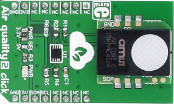
|
|
Air quality 2 click carries the iAQ-Core Indoor Air Quality sensor that measures VOC levels and provides CO2 equivalent and TVOC equivalent predictions. The click is designed to run on either 3.3V or 5V power supply. It communicates with the target MCU over I2C. |
|
|
|
 |
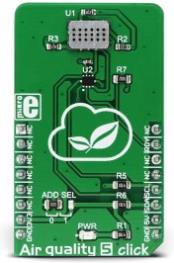
|
|
Air quality 5 click is a triple MOS sensor on a single Click board™, which can detect gas pollution for a number of different gases. The onboard sensor is specially designed to detect the pollution from automobile exhausts, as well as the gas pollution from the industrial or agricultural industry. This Click board™ uses the MiCS-6814, a compact MOS sensor with three fully independent sensing elements in one package: RED sensor, OX sensor, and NH3 sensor. Each of these sensors reacts with the specific type of gases, providing gas readings that including carbon monoxide (CO), nitrogen dioxide (NO2), ethanol (C2H5OH), hydrogen (H2), ammonia (NH3), methane (CH4), propane (C3H8), and isobutane (C4H10). Measurement conversion is handled by the onboard 12bit ADC converter and it is available via the I2C interface. |
|
|
|
 |

|
|
Pollution click has high sensitivity to organic gases such as methanal (also known as formaldehyde), benzene, alcohol, toluene, etc. The click carries the WSP2110 VOC gas sensor with the detection range of 1~50ppm (parts per million). Pollution click is designed to run on a 5V power supply. It communicates with the target MCU over AN and RST pin on the mikroBUS™ line. |
|
|
|
 |
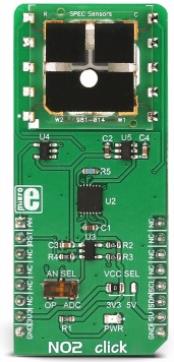
|
|
NO2 click is a very accurate nitrogen-dioxide gas sensor Click board™, equipped with the SPEC amperometric gas sensor which electrochemically reacts with the nitrogen-dioxide (NO2). It is supported by the LMP91000, a high-precision integrated analog front-end IC (AFE), perfectly suited for use in electrochemical sensing applications. The Click board™ also provides the reference voltage required by the sensor and offers a choice between the analog output from the AFE IC buffered with the low noise op-amp, and digital output from the 12-bit SAR A/D converter. |
|
|
|
 |
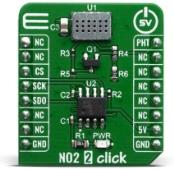
|
|
NO2 2 Click is a gas sensor Click board™, equipped with the MiCS-2714, a compact metal oxide (MOS) sensor. This sensor reacts to the presence of nitrogen dioxide (NO2) and hydrogen (H2). Its impedance changes as a result of a catalytic reaction, allowing it to be used in a voltage divider configuration. This voltage can be sampled by an accurate A/D converter (ADC), allowing data to be read directly over the I2C interface. The MiCS-2714 sensor itself is a robust sensor, which can be used in harsh environment for gas leakage detection, in breath checking applications, early fire detection, etc.
NO2 2 click is supported by a mikroSDK compliant library, which includes functions that simplify software development. This Click board™ comes as a fully tested product, ready to be used on a system equipped with the mikroBUS™ socket.
|
|
|
|
 |
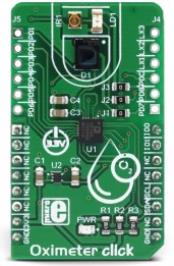
|
|
Oximeter click is a versatile photometric Click board™, perfectly suited for measuring the blood oxygen saturation. It employs ADPD105, a highly configurable photometric front end (AFE) device from Analog Devices. Almost all parameters of the IC are user-configurable, allowing this AFE IC to be used on a wide range of various photometric applications. It utilizes two LEDs (red and infrared), and one photodiode (PD) sensing element, making it is possible to get very accurate and reliable oximetry readings. For those who want to expand the functionality of this Click board™. It offers two headers located on the sides of the Click board™, which allow expanding it with different types of LEDs, PDs, reconfiguring it purpose that way. |
|
|
|
 |
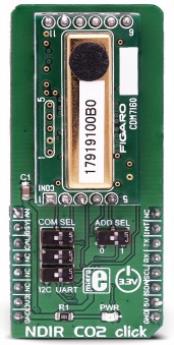
|
|
NDIR CO2 click is an advanced integrated CO2 gas sensor system, which is able to measure an absolute CO2 concentration, by utilizing the CDM7160 integrated sensor. This sensor is based on nondispersive infrared sensing principle (NDIR), with two detection elements: one is used for detecting the wavelength of the IR light spectrum, affected by the CO2 gas, while the other detects the wavelength of the IR light spectrum not affected by the CO2 gas. The integrated MCU processes the readings and outputs the absolute CO2 gas concentration value through UART or I2C interface. Dual wavelength sensing method allows not only accurate absolute readings, but also provides immunity against dust pollution, providing consistent readings in corrosive atmosphere, variable ambient temperature, and over longer periods of time. |
|
|
|
 |

|
|
HVAC Click is a compact add-on board that contains Sensirion's next-generation miniature CO2 sensor. This board features the SCD41, a carbon dioxide sensor build on the photoacoustic sensing principle, and Sensirion's patented PASens® and CMOSens® technology to offer high accuracy at a minor form factor. On-chip signal compensation is realized with the build-in humidity and temperature sensor. It operates within a specified range from 400 to 5'000 ppm, configurable through the I2C interface with a single shot mode supported. This Click board™ is also suitable for indoor air quality applications using an additional SPS30 that allows smart ventilation systems to regulate ventilation in the most energy-efficient and human-friendly way, maintaining low CO2 concentration for a healthy, productive environment.
HVAC Click is supported by a mikroSDK compliant library, which includes functions that simplify software development. This Click board™ comes as a fully tested product, ready to be used on a system equipped with the mikroBUS™ socket.
|
|
|
|
 |
|

